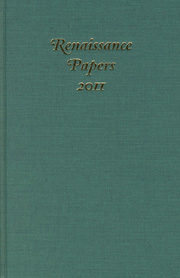Book contents
- Frontmatter
- Contents
- Dedication
- Walking, Waking, and the Armor of Light: Pauline Enactments in Henry IV, Part 1
- Costard's Revenge: Letters and Their Misdelivery in Love's Labour's Lost
- Productive Violence in Titus Andronicus
- Method in Marlowe's Massacre at Paris
- Ending Well: Mixed Genres and Audience Response in the London Theatrical Marketplace, 1604–06
- Birdlime: Sticky Entrapments in Renaissance Drama
- Sacrifice and Transcendence in Sir Philip Sidney's Astrophil and Stella
- The Quest for Certainty in Fulke Greville's A Treatie of Humane Learning
- Traces of the Masque in George Herbert's The Church
- Una Trinitas: Una and the Trinity in Book One of The Faerie Queene
- Reconsidering the 1599 Bishops' Ban on Satire
- Robert Bellarmine the Censor and Early-Modern Humanism
Traces of the Masque in George Herbert's The Church
Published online by Cambridge University Press: 05 April 2013
- Frontmatter
- Contents
- Dedication
- Walking, Waking, and the Armor of Light: Pauline Enactments in Henry IV, Part 1
- Costard's Revenge: Letters and Their Misdelivery in Love's Labour's Lost
- Productive Violence in Titus Andronicus
- Method in Marlowe's Massacre at Paris
- Ending Well: Mixed Genres and Audience Response in the London Theatrical Marketplace, 1604–06
- Birdlime: Sticky Entrapments in Renaissance Drama
- Sacrifice and Transcendence in Sir Philip Sidney's Astrophil and Stella
- The Quest for Certainty in Fulke Greville's A Treatie of Humane Learning
- Traces of the Masque in George Herbert's The Church
- Una Trinitas: Una and the Trinity in Book One of The Faerie Queene
- Reconsidering the 1599 Bishops' Ban on Satire
- Robert Bellarmine the Censor and Early-Modern Humanism
Summary
Here on the table near the window is a vase of peonies
and next to it black binoculars and a money clip,
exactly the kind of thing we now prefer,
objects that sit quietly on a line in lower case.
—Billy Collins, “The Death of Allegory”Years ago, D. J. Gordon wrote the following about the Banqueting House:
The decoration of such a room was a public and political act: a declaration of the meaning of the ruler's kingship. Here Charles, child of the James who had constantly declared, in no blasphemous gesture, kings to be God on earth, and sustained by the iterations of the most powerful Anglican divines, might move, an image, among images, in that late Renaissance world where the relationship between image and what was imaged, sign and what was signified, was still patient of ambiguous readings, and in part powerful by very reason of that ambiguity. Here a king might move delicately but potently between fiction, representation, enaction, identification or participation.
“Patient of ambiguous readings”: we are always struck by the mobility of mind that enabled men and women of this and earlier ages to circulate easily and comfortably amongst generals and particulars, always open to the fluid movement from concept to individual instance and vice versa.
- Type
- Chapter
- Information
- Renaissance Papers 2011 , pp. 103 - 116Publisher: Boydell & BrewerPrint publication year: 2012



